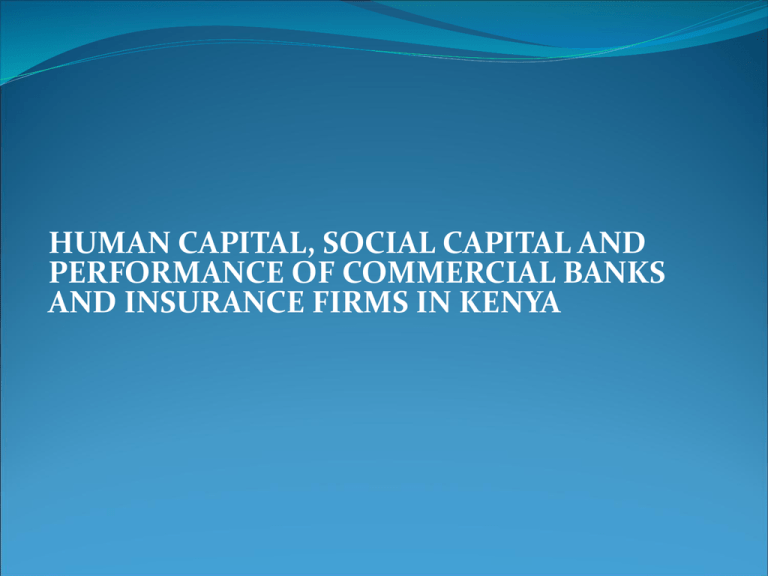HUMAN CAPITAL, SOCIAL CAPITAL AND PERFORMANCE OF
advertisement

HUMAN CAPITAL, SOCIAL CAPITAL AND PERFORMANCE OF COMMERCIAL BANKS AND INSURANCE FIRMS IN KENYA INTRODUCTION A firm's human capital is an important source of sustained competitive advantage (Hitt et al., 2001) and therefore investments in the human capital of the workforce may increase employee productivity and financial results (Pfeffer, 1998). Helping individuals to develop knowledge, skills and competence increases the human capital of the organization. People are better equipped to do their jobs and this is generally of value to the organization (Cunningham, 2002). The resource-based theory argues that firm performance is a function of how well managers build their organizations around resources that are valuable, rare, inimitable, and lack substitutes (Barney, 1991). Human capital as resources meet these criteria, hence the firm should care for and protect resources that possess these characteristics, because doing so can improve organizational performance (Crook, Ketchen, Combs and Todd, 2008). Individuals who accumulate greater human capital will occupy central positions in the social network of organizations and also reap the benefits of social capital. Moreover, those with higher social capital will enhance their value by facilitating the exchange of information across the organization and thereby achieve superior outcomes (Mehra, Kilduff and Brass, 2001). An organization’s human and social capital influence the quality of decisions made. In order to develop an assessment of the decision situation, central decision makers gather most of their information through social ties in their direct environment, which constitute their social capital. One major challenge facing the financial services sector in Kenya is low human capital. There is a human capital challenge facing insurance firms where many insurers are facing mounting skills shortages (www.pwc.com). High labour turnover has also been cited as one of the predictions of failure of insurance firms in Kenya (Kibandi, 2006). This could be due to the low human capital in the insurance industry as well as how human resources are managed. One of the problems that insurance firms and commercial banks in Kenya face is low human capital. A study done by PriceWaterHouseCoopers (2010) on Kenyan insurance firms found that there is a human capital challenge facing insurance firms, where many insurers are facing mounting skills shortages. Yet, investment in recruitment, training and career development often trails behind other financial sectors. The primary focus can often be short-term demands rather than securing the talent companies need to meet longer term strategic objectives. The performance of insurance firms is dependent on human capital attributes such as knowledge, experience and skills because these have a clear impact on organizational results and can build a long-term competitive advantage. Social capital is a key driver of sales performance, especially in knowledge intensive contexts (Ustuner, 2005). With the rise of the networked economy, the ability to build social capital across networks becomes critical (Lesser, 2000). Insurance firms strive at increasing their social networks (formal and informal ties), social skills, and social identity in form of status, identity and reputation because these are critical in enhancing their performance. While banks have traditionally emphasized shrewd use of financial assets, the increasingly competitive global marketplace is causing financial institutions to take a fresh look at the way they manage human capital. The banking industry is being buffeted by a storm of trends and challenges. Customers perceive banking products and services as commodities; shareholders demand healthy growth and fat margins; employee turn over is a persistent problem; and skilled talent is in short supply. The banking and insurance industries were of interest in this study because these are industries where sales performance largely depends on repeat business and the social networks that the firms have established. Research Objective The objective of this study was to establish whether social capital moderates the influence of human capital on the performance of insurance firms and commercial banks in Kenya. LITERATURE REVIEW Human Capital theory was proposed by Schultz (1961) and developed extensively by Becker (1964). Human capital theory suggests that education or training raises the productivity of workers by imparting useful knowledge and skills, hence raising workers’ future income by increasing their lifetime earnings (Becker, 1994). It postulates that expenditure on training and education is costly, and should be considered an investment since it is undertaken with a view to increasing personal incomes. The social capital theory was advanced by an economist, Loury in 1977. The theory of social capital focuses on the resources embedded in one’s social networks and how access to and use of such resources benefits the individual’s actions. The theory assumes that the social structure has a pyramidal shape in terms of accessibility and control of such resources. The higher the position, the fewer the occupants, and the higher the position, the better the view it has of the structure. Human Capital One stream of research defines human capital as the abilities individuals possess (Burt, 2000). Another stream of research incorporates education and experience into human capital. Human capital is formed by aptitudes, competences, experiences and skills of internal members of the organizations (Bontis et al., 2002). Pil and Leana (2009) define Human capital as an individual’s cumulative abilities, knowledge and skills developed through formal and informal education and experience. From an organizational perspective, human capital is the result of a firm's deliberate investment through the selective hiring of employees with high general skills (or formal education) plus a firm investment in training of more specific skills through in-house training activities (Lepak and Snell, 1999, 2002; Skaggs and Youndt, 2004). Human capital is formed by aptitudes, competences, experiences and skills of internal members of the organizations (Bontis, 1999; Bontis et al., 2002). Organizations can increase their human capital by attracting individuals with high skills from the external labor market and/or by internally developing the skills of their current members. Social Capital Social capital has been defined as the structure of individuals’ contact networks, the pattern of interconnection among the various people with whom each person is tied (Raider and Burt, 1996). Social capital consists of the stock of active connections among people: the trust, mutual understanding and shared values and behaviours that bind the members of human networks and communities and make cooperative action possible (Cohen and Prusack, 2001). The concept of social capital refers to social networks and reciprocity norms associated with them (Putnam, 2000). This form of capital springs from stable relationships maintained by individuals, groups and organizations in society. Baron and Markmnan (2000)observe that social capital consists of social networks (formal and informal ties), social skills (interpersonal and communicative ability), and social identity (status, identity and reputation). Social capital exists in the relationships between and among persons and extends the more that the position one occupies in the social network constitutes a valuable resource (Friedman and Krackhardt, 1997). Firm Performance Firm performance is defined as “the economic outcomes resulting from the interplay among an organization’s attributes, actions and environment” (Combs et al., 2005, p. 261). The conceptual domain of firm performance can be specified only by relating this construct to the broader construct of organizational effectiveness. Organizational effectiveness is defined as “the degree to which organizations are attaining all the purposes they are supposed to” (Strasser, Eveland, Cummins, Deniston, & Romani, 1981, p. 323). Venkatraman and Ramanujam’s (1986) performance-measurement framework focuses on multiple indicators of organizational performance. These indicators are financial performance, operational performance and overall effectiveness. Financial performance includes overall profitability (indicated by ratios such as return on investment, return on sales, return on assets, and return on equity), profit margin, earnings per share, stock price and sales growth. Operational performance refers to non-financial dimensions, and focuses on operational success factors that might lead to financial performance. Operational performance includes both product-market outcomes (including market share, efficiency, new product introduction and innovation, and product or service quality) and internal process outcomes (productivity, employee retention and satisfaction, and cycle time). Human Capital, Social Capital and Firm performance Adler and Kwon (2002) highlight information as being the first direct benefit of social capital. They argued that social capital facilitates access to broader sources of information and improves information’s quality, relevance and timeliness. These conditions allow individuals to enhance their knowledge through everyday interactions with colleagues. Similarly, Reed et al. (2006) state that the inimitable value of human capital can be enhanced by social relations. Their argument is that, given competent and credible participants from a diverse set of disciplines, a network of rich, social connections can reduce the amount of time and investment required to gather information and can serve as a valuable conduit for knowledge diffusion and transfer. . Cabello-Medina, Lopez-Cabrales and Valle-Cabrera (2011) argue that high levels of social capital can enhance the skills and capabilities of individuals (human capital). Moreover, Baldwin et al. (1997) have indicated that an individual who is central in the social network is, over time, able to accumulate knowledge about task-related problems and workable solutions. This expertise not only enables the central individual to solve problems readily, but also serves as a valued resource for future exchanges with coworkers. RESEARCH METHODOLOGY The research design that was used is descriptive cross- sectional design. The target population of this study was all the insurance companies and commercial banks in Kenya, where a census survey was carried out on all the 88 firms which comprised all licensed commercial banks and insurance firms in Kenya According to the Insurance Regulatory Authority (IRA) list of licensed insurance firms as at 31st December 2012, there were 45 licensed Insurance firms in Kenya (www.ira.go.ke). There were 43 commercial banks in Kenya as at 31st December 2012 (Bank Supervision Annual Report, 2012). The organization was the unit of analysis and the target respondents were the Human Resource Managers, Operations Managers and Marketing Managers of the commercial banks and insurance firms. Regression analysis was used to establish the nature and magnitude of the relationships between the variables of the study and to test the hypothesized relationship. Descriptive statistics such as frequencies and percentages were computed for organizational data and multiple choice questions in order to describe the main characteristics of the variables of interest in the study. Mean scores were computed for likert type of questions. Data was presented in form of tables. Operationalization of Variables Human Capital Educational level Tenure Job-related skills Social Capital External social networks Internal social networks Resources obtained through internal and external social networks Firm Performance Financial indicators Return on Assets, Return on Equity Non-financial indicators Quality of service, Customer Satisfaction, Efficiency in service delivery Study findings The objective of the study was to determine whether the influence of human capital on firm performance was moderated by social capital. The study revealed that social capital does not moderate the influence of human capital on firm performance, considering both financial and non-financial measures. The Baron and Kenny approach in testing for moderation was employed and the results yielded an insignificant interaction between human capital, social capital and firm performance in spite of a statistically significant model. The hypothesis that the influence of human capital on firm performance is moderated by social capital was therefore not confirmed. The researcher further tested for mediating effect of social capital on the influence of human capital on firm performance on an exploratory basis and the tests yielded positive results for mediation. These findings seem to agree with previous studies that have found a link between human capital, social capital and firm performance. Cabello-Medina, Lopez-Cabrales and ValleCabrera (2011) argue that social capital and human capital are not independent variables; rather, they interact to improve innovative performance. High levels of social capital can enhance the skills and capabilities of individuals (human capital). Moreover, Baldwin et al. (1997) have indicated that an individual who is central in the social network is, over time, able to accumulate knowledge about task-related problems and workable solutions. This expertise not only enables the central individual to solve problems readily, but also serves as a valued resource for future exchanges with coworkers. Although human capital may be the origin of all knowledge, learning requires that individuals exchange and share insights, knowledge and mental models, which represent social capital (Senge, 1990). Burt (1997) argues more vehemently that human capital needs social capital, saying that human capital becomes worthless without the opportunities to apply it afforded by social capital. Moreover, he suggests that there is an interactive effect whereby managers with more social capital obtain greater benefits from their human capital. There is minimal empirical evidence of moderating effect of social capital on the influence of human capital on firm performance. However, Lin and Huang (2005) did a study on the role of social capital in the relationship between human capital and career mobility, where the moderating and mediating effect were tested. The findings revealed that social capital mediates the relationship between human capital and career mobility. Conclusion The findings revealed that social capital does not moderate the influence of human capital on firm performance. This is because social capital interacts with human capital hence improving firm performance. The mediation test confirmed that social capital mediates the influence of human capital on firm performance. Recommendations The research findings revealed that social capital mediates the influence of human capital on firm performance. The implication of this to practice is that firms should strengthen their social networks and linkages so as to maximize on resources that may be obtained through such networks. Employees with the relevant knowledge, skills and competencies should be encouraged to obtain and share information through the social networks that organizations establish to achieve greater synergy in increasing competitiveness. BARON & KENNY APPROACH The influence of human capital on return on assets is moderated by social capital The Baron and Kenny approach in testing for moderation was employed for the purposes of this study guided by the equation: Y= β0+β1X+β2Z+β3XZ Where X= Independent variable (human capital) Z= Moderator (social capital) XZ= Product of the standardized scores for the independent variable and the moderator Y= Return on Assets Ζ = X- µ σ Z = the standardized score X = the X value µ= the mean of the distribution σ= the standard deviation of the distribution. The resultant scores give a distribution that has a mean score of zero and a standard deviation of one. The above hypothesis would be supported if the effect of the interaction between human capital and social capital (XZ) on return on assets is statistically significant. The Baron and Kenny approach in testing for mediation For mediation effect to be considered positive, four conditions should be fulfilled: The independent variable is significantly related to the dependent variable in the absence of the mediating variable The independent variable is significantly related to the mediator variable The mediator variable is significantly related to the dependent variable. When controlling for the effects of the mediating variable on the dependent variable, the effect of the independent variable on the dependent variable is insignificant in the presence of the mediating variable









